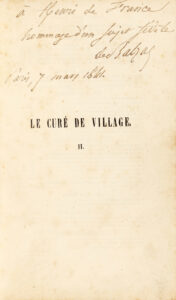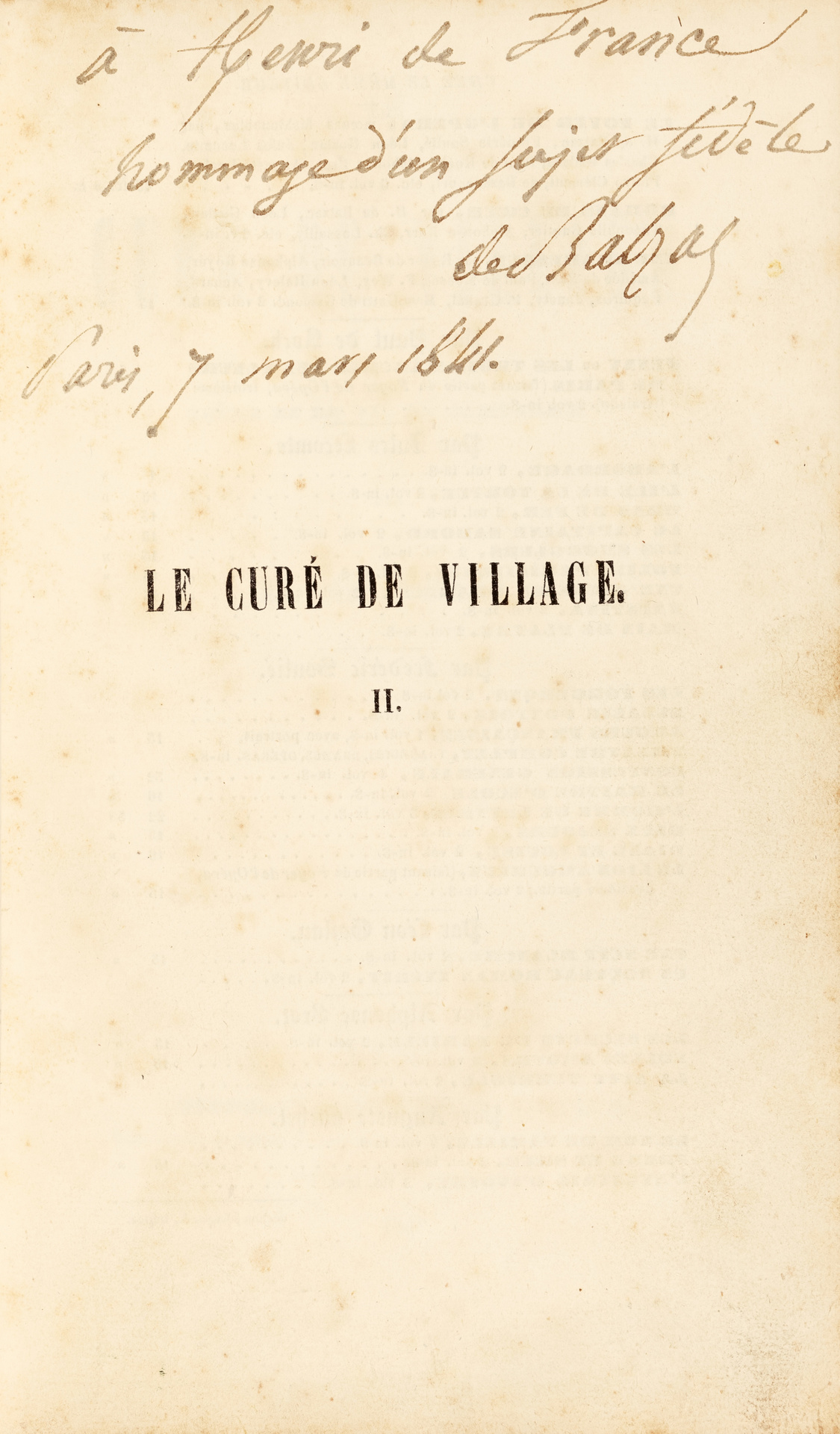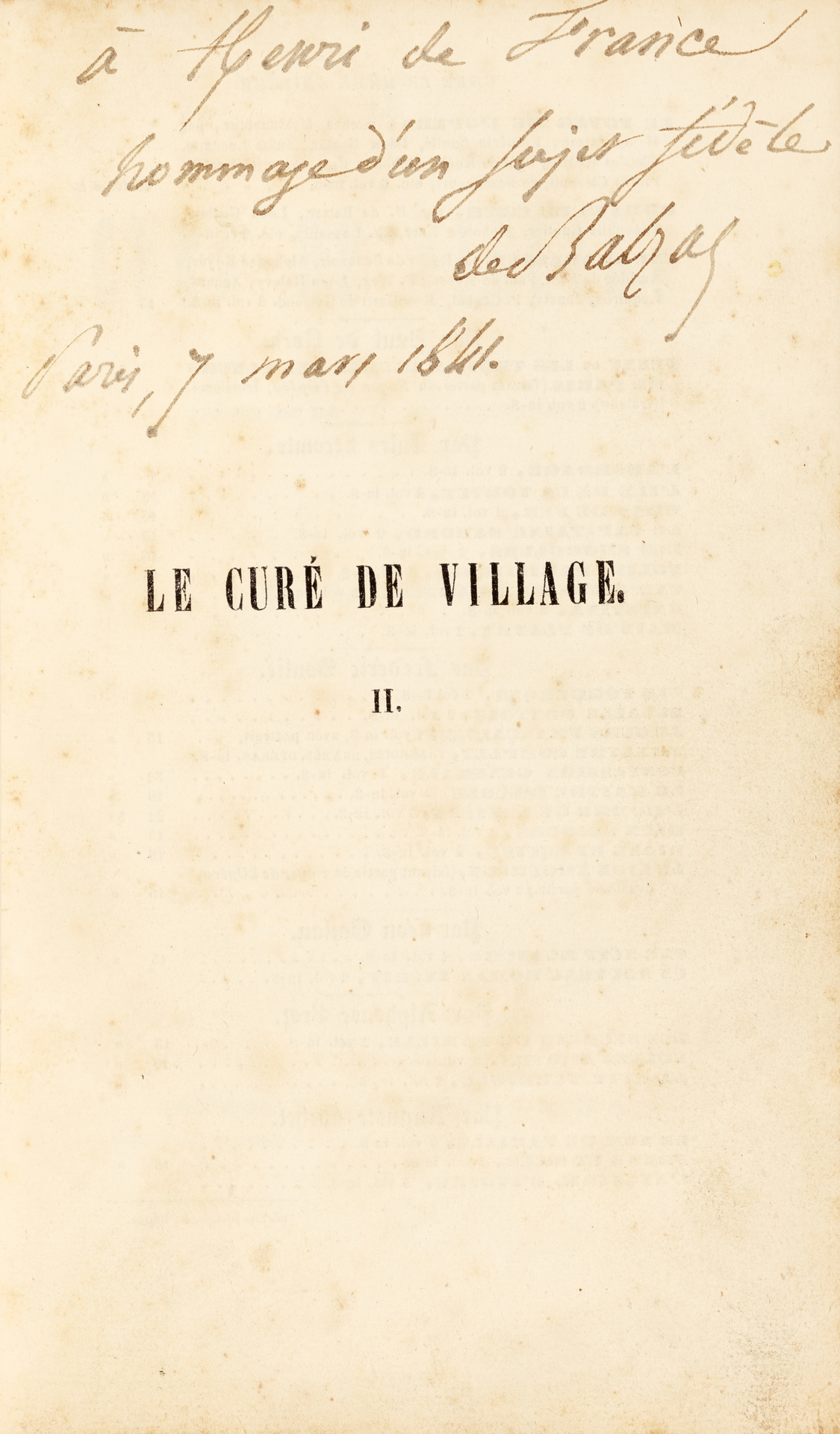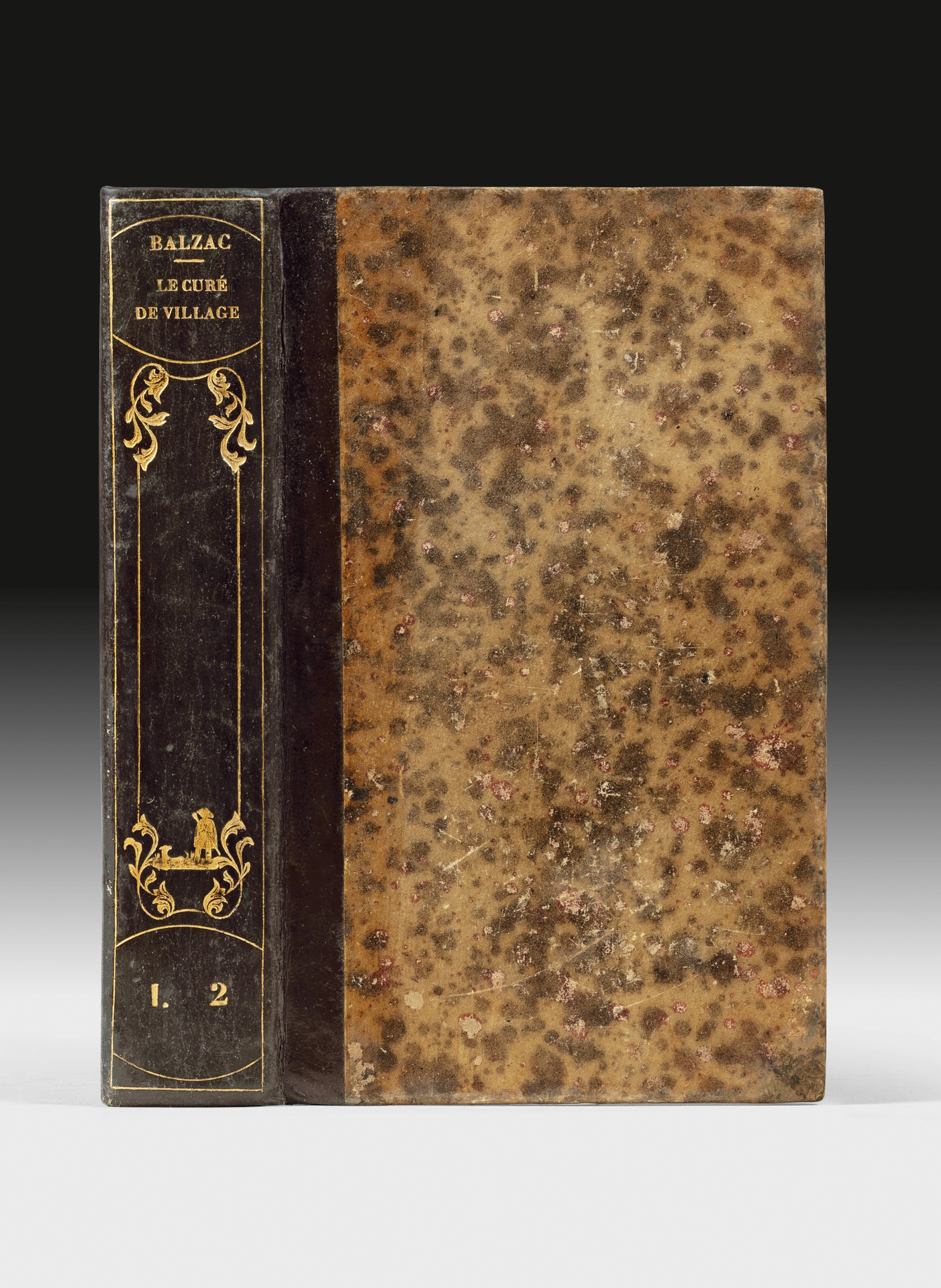Paris, Hippolyte Souverain, 1841.
Two parts bound in one volume 8vo [206 x 126 mm] of : I/ (1) ll, xii pp., (2) ll, pp. 21-337, (1) p. (errata), jump in number from p. 308 to 311 without missing; II/ (2) ll, 378 pp., (1) l, small tear on p. 37 without damage to the text, scattered foxing or spotting. The half-title of volume 1 has been removed at the time. Bound in brown half-sheepskin, flat spine decorated in long with a small tool depicting a shepherd and his dog. Contemporary binding.
« Rare » first edition (Clouzot, 23) of this novel by Balzac being part of the “Human Comedy”.
Vicaire, I, 216-217 ; Carteret, I, 76.
“The village priest is Abbot Bonnet, who in Montégnac, Limousin, assists Mrs Graslin in her generous charity work. The plot of the novel revolves around an old crime committed by a worker, Jean-François Tascheron, who was secretly Mme Graslin’s lover and went to the scaffold without making the slightest disclosure. And really a shadow of mystery surrounds the reader in this terrible story…” (Dictionary of the Works of the author, p. 3).
(Dictionnaire des Œuvres, II, 178).
Precious and extremely rare autographe dedication from Balzac to Henri de France (Duke of Bordeaux then Count of Chambord) on the half-title of the second volume: “To Henri de France, homage of a faithful subject, from Balzac, Paris, March 7, 1841“.
This copy and this dedication were quoted by the present Count of Paris in a speech in Vendome in 2000 on the occasion of the Balzac year.
Balzac confirms his legitimist sentiments by claiming to be a subject of the count de Chambord and not of the then reigning Louis-Philippe.
Henri d’Artois, grandson of France, Duke of Bordeaux, was a prince of the royal family of France, head of the Capetian house of Bourbon, better known by his courtesy title of Count of Chambord, born on 29 September 1820 at the Tuileries Palace in Paris, and died on 24 August 1883 at the Castle of Frohsdorf in Lanzenkirchen, Austria. Grandson of King Charles X, head and last representative of the elder and French branch of the House of Bourbon, he was pretender to the crown of France from 1844 to his death under the name of Henri v.
The name Artois given to him by King Louis XVIII is the one that appears on his birth certificate, but he no longer used it from 1844 (the date of the death of his uncle the Count of Marnes, the last Dauphin of France), considering from then on to bear de jure the name “de France”.
Furthermore, from the same date he opted for the name of Bourbon in his relations with foreign states (in particular those which granted him political asylum). Under the Restoration, Henri d’Artois bore the title of Duke of Bordeaux, given to him by Louis XVIII in homage to the first city to rally to the Bourbons in 1814.
On 25 July 1830, Charles X promulgated orders that provoked the 1830 revolution, also known as the Three Glorious Days, which lasted three days. On 30 July 1830, a group of Parisian politicians launched the candidacy to the throne of Louis-Philippe, Duke of Orleans. On 2 August 1830, Charles X abdicated in favour of his grandson Henri d’Artois. The order of succession, however, gave the throne to the king’s eldest son, the dauphin Louis-Antoine de France, who was to reign as Louis XIX. But he was forced to sign his father’s abdication. Thus, the crown would pass to the young Henry, Duke of Bordeaux, who would become Henry V. Charles X sent this act of abdication to the Duke of Orléans, entrusting him de facto with the regency, having already appointed him as of 1 August 1830 as Lieutenant-General of the kingdom. In this letter, he expressly charged him with proclaiming the accession of Henri V. Louis-Philippe d’Orléans did not consider himself regent from 2 August; he was content to register the abdication of Charles X and the renunciation of his son, without having Henry V proclaimed. On 7 August, the Chamber of Deputies and then the Chamber of Peers called the Duke of Orléans to the throne, who took the oath of office on 9 August, under the name of Louis-Philippe I. Nevertheless, from 2 August, some Legitimists (who were to be called Henriquists) began to refer to the nine-year-old Henri as Henri V. The royal family went into exile in England on 16 August 1830.
The death of the dauphin “Louis XIX” on 3 June 1844 led his supporters to rally behind the Count of Chambord, who became the eldest of the House of France and was henceforth recognized as Henry V by all the Legitimists, who remained in opposition during the July Monarchy, the Second Republic and the Second Empire.
“In 1841, in ‘Le Curé de village’, as part of a diatribe against the legal institution, Balzac is explicitly opposed to the death penalty, echoing Victor Hugo’s ‘Dernier jour d’un condamné’ (1829). It is not surprising that he ‘became the merciless censor of the philipardic monarchy, castigating in his works the bourgeoisie, greedy for favours and money”.
The fact that Balzac wrote his dedication on the half-title of the second volume, even though the two volumes were already bound in a single volume at the time, and that the copy was expunged from the half-title of the first volume, reveals the risks incurred by Balzac as he asserted his support to Henri de France and not to the then reigning Louis-Philippe.
He also calls the Count of Chambord Henri de France in this dedication dated March 1841, whereas the Count of Chambord did not adopt this name until 1844.
One can imagine that the Count of Chambord, receiving this dedicated present from his faithful subject Honoré de Balzac, was afraid that such a mark of loyalty would harm his author, and so asked him to transpose his dedication to the middle of the volume, on the half-title of the second volume, thus making it less visible and less compromising, removing at the same time the first half-title of the volume.
Fascinating copy of a prestigious provenance, of the highest historical interest, which reveals Balzac’s legitimist positions.



